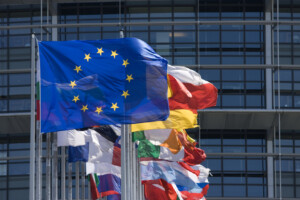 In its efforts to tackle the challenges related to waste, overpackaging, and sustainable production, the European Commission not only introduces additional regulations, such as the Single-use Plastics Directive, but also focuses on revising existing legislation. A milestone in the EU’s approach to respond to the environmental challenges we are facing is the revision of the Packaging and Packaging Waste Directive (PPWD). Together with the development of a policy framework on bio-based, biodegradable and compostable plastics and the revision of the Waste Framework Directive, the PPWD ranks amongst the most important policy developments for the bioplastics industry. With 48 percent of all applications represented by packaging, it is by far the largest sector for bio-based, biodegradable and compostable plastics.
In its efforts to tackle the challenges related to waste, overpackaging, and sustainable production, the European Commission not only introduces additional regulations, such as the Single-use Plastics Directive, but also focuses on revising existing legislation. A milestone in the EU’s approach to respond to the environmental challenges we are facing is the revision of the Packaging and Packaging Waste Directive (PPWD). Together with the development of a policy framework on bio-based, biodegradable and compostable plastics and the revision of the Waste Framework Directive, the PPWD ranks amongst the most important policy developments for the bioplastics industry. With 48 percent of all applications represented by packaging, it is by far the largest sector for bio-based, biodegradable and compostable plastics.
Bioplastics need a clear, coherent, and fit for purpose regulatory environment
Bioplastics can make significant contributions to successfully tackle the environmental challenges we all aim to overcome, but they require a transparent and reliable regulatory environment to fully tap their potential. However, so far, bioplastics lack a comprehensive regulatory EU policy approach, a fact that had also been confirmed recently by the European Commission’s “Bioeconomy Strategy Progress Report”. Therefore, it is important that the revision of the PPWD, as a cornerstone in establishing such a regulatory environment for bioplastics, fully acknowledges their role within the circular economy as well as their potential to defossilize the EU economy. All requirements outlined in the revised PPWD must go in line with the priorities of the European Green Deal, such as establishing a proper waste management infrastructure, reducing the dependency on fossil resources, and encouraging innovation in packaging.
Driving the transition towards a low-carbon circular economy requires carbon to be regenerated using renewable resources. Therefore, the promotion of alternative feedstocks in EU packaging legislation should not be limited to recycled feedstock alone. It must also include bio-based feedstock, as this can significantly contribute to achieving climate neutrality in the EU by 2050 and to closing the carbon loop. At the same time, biodegradable and compostable plastics help in closing the material cycle as well as the biological one. In this regard, it should not be overlooked that a particular benefit of biodegradable plastic packaging is that it can help collect a larger share of the municipal kitchen waste which would otherwise end up in landfill or incineration.
Definition of recyclable packaging
The current exclusive focus on the recycled content should be reconsidered. Mechanical recycling alone will not be enough to end Europe’s dependency on fossil resources, nor will it stop the current trend of over-packaging and excessive waste in the EU. Therefore, the EU-wide definition of recyclable packaging as part of the PPWD revision must also include compostable packaging, which is designed to biodegrade in industrial composting (certified EN13432). Through the composting process, it closes the organic carbon cycle and serves as soil improver. In this regard, the promotion of recyclability in packaging is very much supported by the bioplastics industry. However, the proposed 95% mandatory recyclability threshold will not lead to better environmental results. It will, in fact, lead to market distortions as it doesn’t distinguish by between different applications, materials, and market shares.
Revision of Essential Requirements
The revision of the PPWD also foresees an amendment to the Essential Requirements for Packaging (ER). With regards to the ER for biodegradable and compostable packaging, the PPWD’s revised version should not scrap the current requirements. It is also important that the ER apply to all packaging following the principle of material neutrality. Before putting a packaging on the market, several other aspects should also be taken into consideration, e.g., prevention and re-use should be reviewed and, in the case of recycling, all technologies should be compared on an equal level (recycling technology neutrality). Organic recycling should be the preferred end-of-life method in case it increases the capture rate of bio-waste, and compostable packaging should be exempted from targets regarding recycled content. In order to support, and not hamper, the EU’s industrial competitiveness and its innovative products, the Commission should also rethink its proposal of a legally binding list of applications for packaging.
The legal text of the PPWD is still in the revision phase, and a first proposal is expected to be published in November 2022. As this revision provides a great opportunity to adequately address the important role that bio-based, biodegradable and compostable plastics can play in reducing environmental and climate impacts, it would be important to:
- include a provision in the PPWD that compostability falls within the definition of recyclability.
- consider bio-based content equal to recycled content for packaging.
- acknowledge the benefits brought by bio-based plastics in defossiling the economy.
- incentivize innovation in the (bio)economy and include a 10-years minimum for innovative products placed on the market to find a proper recycling stream.
- not include a 95 percent recyclability threshold in the definition of recyclable packaging.
- promote an internal market for bio-based, biodegradable, and compostable plastics.
To receive more detailed information on the PPWD revision and European Bioplastics’ view on the individual elements, please read our EUBP position paper which is also summarized in a short version. The EUBP website also includes a subsection with information on the PPWD.